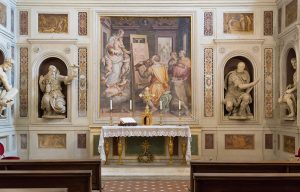Private Landmarks Open during FAI Spring Days

At a time when days are getting longer and people are looking to go outside, the 26th annual FAI Spring Days (Giornate FAI di Primavera) allows visitors to experience historical places in Italy like never before in a single weekend (March 24 – 25). All venues are private properties and welcome guests only once a year with guided tours.
FAI SPRING OPEN DAYS
This year, 1,000 landmarks will be accessible on March 24-25 throughout Italy. Over the past 25 years, FAI (Fondo Ambiente Italiano) volunteers have opened over 11,000 locations in 4,700 cities. FAI is a non-profit foundation founded in 1975 with the aim of protecting and enhancing the Italian historical, artistic, and landscape heritage.
Spring Days allows a wide variety of places such as former hospitals and current art sites to be toured, bringing attention to the importance of Italy’s cultural heritage. The event is free with the opportunity to make a donation after the guided visit if one wishes. Money from the fundraiser is used to preserve and maintain many of the sites.
Visiting the FAI website, one can plan a weekend to explore this year’s must-see locations. It is a good idea to bring identification in case it is asked for at the door.
FLORENCE
Cloister and San Luca Chapel, Santissima Annunizata (Piazza Santissima Annunziata)
Open: Saturday and Sunday 10 am – 5 pm.
The Chapel of San Luca is known as the “Chapel of the Artists” and the viewer can admire frescoes by Pontormo and Vasari in addition to the Trinity by Alessandro Allori.
FAI Spring Days coincides with the 2018 Florentine New Year, which is still an important part of local tradition. From 1250 to 1750, the people of Florence gathered in the SS Annunziata on March 25 to welcome the arrival of spring and to officially celebrate the Annunciation, when the Angel Gabriel told Mary that she would be the mother of Christ.
Ex Ospedale di San Matteo, Fine Arts Academy (Via Bettino Ricasoli, 66)
Open: Saturday and Sunday 10 am – 5 pm.
Where the Fine Arts Academy is located today is the former premise of Spedale San Matteo. Still visible in the building are the 14th, 15th and 16th century frescoes. Grand Duke Pietro Leopoldo opened the academy as a free center for art education in 1784. The library has valuable editions and rare prints. There are also 18th and 19th century plaster casts that students used as models.
Le Murate (Piazza delle Murate)
Open: Sunday 10 am – 5 pm.
Originally a secluded convent, later a men’s prison for 100 years until 1985, political dissidents were detained at Le Murate before being transferred to concentration camps during WWII. More recently, the complex’s function has taken an altruistic turn as the headquarters of the Robert F. Kennedy (RFK) Center. The center is headed by Kennedy’s daughter Kerry and is focused on social justice. La Murate is also home to a literary café that serves artists, writers, and musicians by providing them with a chance for exposure, as well as a haven to enhance creativity with many private events.
The Ancient Hospital of San Giovanni di Dio (Borgognissanti, 20)
Open: Sunday 10 am – 5 pm.
The hospital was founded and donated to the citizens of Florence on July 12, 1400. It was dedicated to Santa Maria dell’Umiltà its main purpose was to care for pilgrims and the poor. The Vespucci family moved to Florence in the 14th century and owned many houses in Borgognissanti. The Vespuccis became prominent in Florentine political, economic and charitable affairs, thus founding the hospital. In the 16th century, the Medici family donated the hospital to Giovanni Ciudad, the head of the monastic order known as Fatebenefratelli.
In 1635, the brothers from Portugal greatly expanded the original structure. During of the 19th century, they increased the number of operating rooms and the hospital remained in service until the 1970s; some clinics and services were available until 2005. The hospital moved to a new building outside of town in 1982.
The Church of Ognissanti: Cloister and Refectory (Borgognissanti, 42)
Open: Saturday and Sunday 10 am – 5 pm.
Discover the secrets behind this church founded in the 13th century: a wooden crucifix by Giotto, and the tomb of Botticelli, the artist of Primavera (Spring) and the Birth of Venus in the Uffizi. Around 1230 the area attracted a Lombard order of lay brothers, the Umiliati, who apart from building the church controlled much of Florence’s vital wool industry.
Following the Florentine custom that the monastery dining room be frescoed with a Last Supper, they awarded the commission to Domenico Ghirlandaio (1449-94), who had just completed the Santa Fina mural cycle in San Gimignano. (elise loveless)
